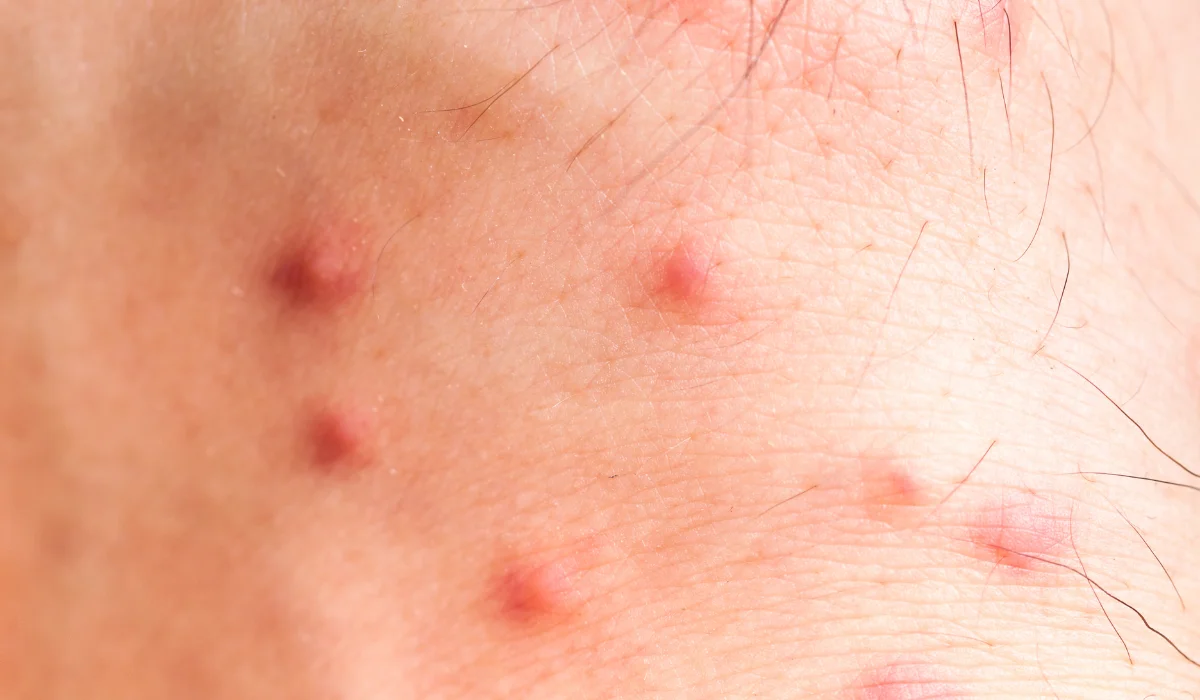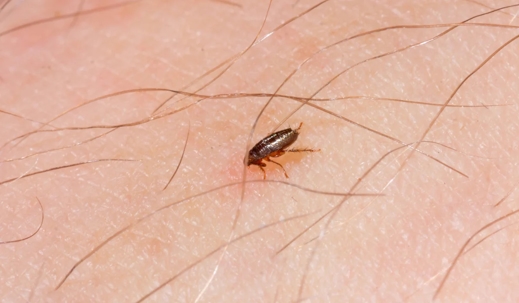Are Those Flea Bites? Here’s How to Tell
Flea bites are small, distinctive marks that can appear on the skin when these tiny, wingless insects have bitten someone. They typically manifest as tiny red bumps, often itchy and sometimes painful due to secondary infections.
While flea bites can look similar to those from other insects, they usually appear in groups or lines and are most commonly found on the lower legs and feet.
Could those mysterious bites be from fleas? Keep reading to learn more about identifying and managing flea bites and discover effective measures to keep these pesky insects at bay.
Key Takeaways
- Flea bites are small, intensely itchy red spots that often cluster in groups or lines and can cause severe allergic reactions in sensitive individuals.
- Unlike mosquito or bed bug bites, flea bites typically appear on the lower parts of the body, like the legs, and around the ankles and waist.
- Immediate treatments for flea bites include applying ice packs, calamine lotion, and corticosteroid creams to alleviate itching and inflammation.
- If flea bites show signs of infection or don't improve with basic remedies, it's essential to consult a healthcare provider.
- Preventing flea bites involves regular cleaning practices, such as using flea combs on pets, washing bedding in hot water, and possibly seeking professional pest control services.
What Do Flea Bites Look Like?

While you are not an ideal host, female fleas feed on human blood. As they bite humans, flea saliva triggers an immune system response. Similarly, cats or dogs exhibit an immune response when they have fleas.
Characteristics of Flea Bites
Here are the distinguishable characteristics of flea bites:
Size | Small, typically no larger than the head of a pin or a speck. |
Color | Red spots due to inflammation caused by the flea's saliva. |
Clustering | Flea bites often appear in groups or in a straight line. |
Halo | Sometimes, a small, red "halo" might surround the raised bump. |
Itchiness | Flea bites are intensely itchy. Scratching can worsen the irritation. |
Severe Allergic Reaction | Flea bites are intensely itchy. Scratching can worsen the irritation. |
Flea Bites vs. Other Insect Bites
Knowing how to differentiate the signs of flea bites from other insect bites helps to manage and prevent future bites.
Since flea, mosquito, and bed bug bites all present differently on the skin, here’s how they compare with their varying symptoms.
Insect Bites | Appearance | Symptoms | Typical Bite Sites |
Flea Bites | Small red bumps in groups or a line | Itchy, sometimes with hives or welts | Legs and feet, particularly around ankles and waist |
Mosquito Bites | Puffy and redder isolated bumps | Itchy | Any area of exposed skin |
Red bumps, often in a zigzag pattern | Itchy, irritated skin | Face, neck, arms, and hands |
Where Can You Find Flea Bites on the Body
Flea bites are distinctive and usually easy to spot. Because fleas tend to jump from carpets and grass onto these areas, they appear most commonly on the lower parts of the body, such as:
- Legs and feet
- Waist
- Ankles
- Armpits
- Bends of elbows and knees
Your dogs and cats are also susceptible, with these areas commonly bitten:
- Belly
- Hindquarters
- Neck
How to Treat Flea Bites
After being bitten by fleas, addressing the discomfort and promptly reducing the chance of secondary skin infections is essential.
Immediate Remedies for Relief
The first course of action should involve alleviating the symptoms associated with flea bites. Here's a practical guide to immediate remedies:
Remedies | Usage Instructions |
Ice Packs or Cold Compresses | Apply to the bite areas to reduce swelling and numb the itch. |
Calamine Lotion | Dab onto the bites to soothe itching and irritation. |
Over-the-Counter Antihistamines | Take as directed to manage allergic reactions and reduce itching. |
Corticosteroid Cream | Apply a small amount to bites to decrease inflammation and itching. |
Warm Water with Soap | Wash the flea bite area with warm water and gentle soap to help remove any irritants. |
When to See a Healthcare Provider
Flea bites typically don't require a doctor's visit when anti-itch creams work, but seeking medical advice is crucial in cases such as:
- Signs of infection include increased redness, warmth, swelling, or pus at the bite sites.
- A large area of redness and inflammation around the bites.
- Symptoms of a severe allergic reaction include difficulty breathing, dizziness, or hives.
- Persisting symptoms that don't improve with over-the-counter treatments.
- In pets, there is noticeable hair loss around flea bite areas, especially at the base of the tail, back legs, or belly.
How to Prevent and Avoid Flea Bites
Since fleas can transmit flea-borne diseases like cat scratch disease, tapeworms, and typhus, getting rid of them and preventing their bites becomes crucial.
Effective Home Remedies
As homeowners and pet owners, you can tackle the presence of fleas in various ways. Here are some home remedy methods for treating flea infestations:
Methods | Application | Notes |
Flea Comb | Daily on pet’s fur | Removes adult fleas and eggs |
Wash Pet Bedding and Mattresses | Weekly in hot water | Kills larvae and disrupts the life cycle |
DIY Flea Treatments | As needed in affected areas | Natural options include diatomaceous earth |
Vacuum Regularly | Daily in high-traffic areas | Removes fleas at all stages of the life cycle |
Is It Time to Call the Pest Control?
If you notice multiple bites and feces, usually small and red marks, on your body or that of family members, this could indicate a substantial flea infestation that may require medical attention.
In these situations, a professional pest control company (like us at Native Pest Management) can offer effective solutions beyond home remedies or over-the-counter treatments.
We have access to industrial-grade insecticides and growth inhibitors that can address the root of the infestation, ensuring a long-term solution to the flea problem.
